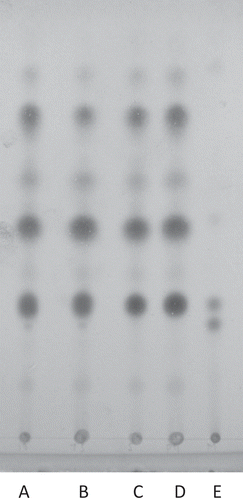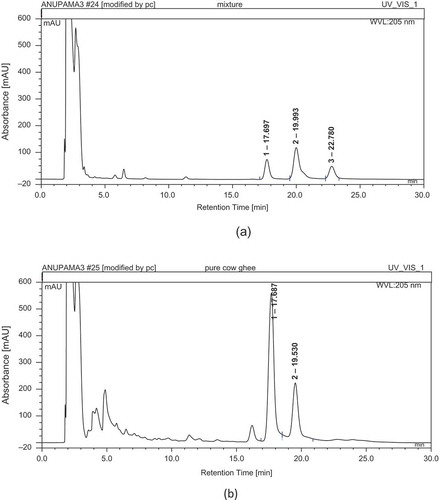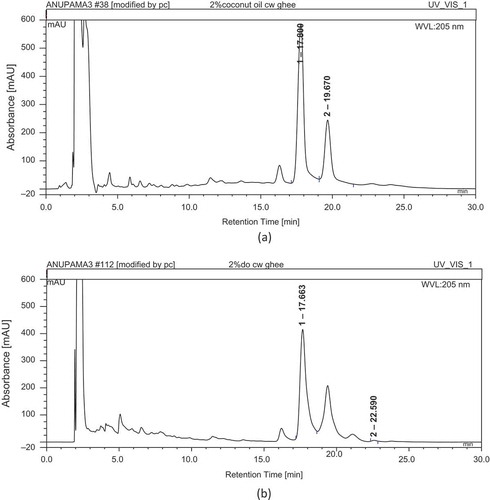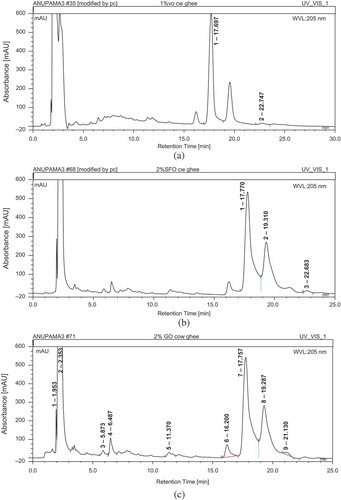Abstract
An efficient, fast, and reliable reversed phase high-performance liquid chromatography based method was developed to detect specific adulterant in premium and pure ghee (clarified butterfat) samples. The method is based on the detection of cholesterol and β-sitosterol as markers in the unsaponifiable matter of pure ghee and adulterated ghee samples, respectively. The reversed phase high-performance liquid chromatography method resolved cholesterol, stigmasterol, campasterol, and β-sitosterol at Rt values of 17.681 ± 0.122, 19.7 ± 0.2, 20.2 ± 0.2, and 22.7 ± 0.2 min., respectively. β-sitosterol served as an indicator for the adulteration in ghee by plant and specific adulterant oil at dose dependent manner (1–5 g/100 g of ghee). Validation of the method revealed that it was fast, economical, highly reliable, and comparable with the reversed-phase thin layer chromatography method with no false negatives.
Introduction
Determination of food authenticity and detection of adulteration are major concerns not only to consumers, but also to industries and policy makers. One of the major authenticity issues from the food products is the alteration of food ingredients labeling, whereby the high value materials are substituted with the cheaper ones without declaring it on the label, in particular with the dairy products as it has wide applications in the food industries.[Citation1] Ghee, widely known as the Indian counterpart for clarified butterfat, is usually prepared from cow or buffalo milk or combination thereof. Milk fat is the most preferred and premium fat in many of the Asian countries like India, Pakistan, Bangladesh, Sri Lanka, and Nepal. A very complex situation arises especially during lean season in the summer months, wherein the supply of milk and ghee (clarified butter fat) falls short of demand. Due to the premium nature, high price, and demand—supply gap, it attracts the attention of unscrupulous traders to adulterate it with low-priced fats, such as vegetable oils, animal body fat, concoction of these fats, inedible mineral oils, and most recently with some specific adulterant oils. In most of the cases the adulteration is carried out in such a manner that the physico-chemical quality parameters of such adulterated milk fat are similar with the standards of genuine milk fat. Hence, the physico-chemical parameters based methodologies fail in ascertaining the quality of such adulterated ghee. Other methodologies such as normal phase thin layer chromatography has its own limitations in resolving the cholesterol and ß-sitosterol an index sterol in plant oils/fats.[Citation2,Citation3] On the other hand reversed-phase thin layer chromatographic (RP-TLC)[Citation4] methods involving paraffin wax or n-decane on thin layer chromatographic (TLC) plates are time consuming and also have poor reproducibility and sensitivity issues. However, an RP-TLC method based on the tracer compound, i.e., β-sitosterol,[Citation5] was found to be rapid and had specificity for detecting vegetable oils in ghee. The RP-TLC based method could detect the adulteration of ghee with coconut oil up to 7.5 g/100 g, soybean oil, sunflower oil, and groundnut oil up to 1 g/100 g, while, specific adulterant oil up to 2 g/100 g level. In the present investigation, a rapid RP-HPLC based method has been developed and compared for its efficacy with RP-TLC method.[Citation5]
Material and methods
β-sitosterol, Campasterol, Cholesterol, Stigmasterol (Sigma Aldrich, USA), RP-TLC plates: TLC silica gel 60 RP-18 F 254S (Merck Specialities Private Ltd., Mumbai, India), high-performance liquid chromatography (HPLC) system and accessories: Dionex, Ultimate 3000 (Dionex softron gmbH, Germany).
Preparation of Pure Ghee (Clarified Butter Fat) Samples
Cow and buffalo milk used for the preparation of respective ghee samples was collected from (1) Livestock Research Centre of the National Dairy Research Institute, Karnal. (2) Local dairy farms situated around Karnal city. Samples of cow/buffalo ghee were prepared by direct cream heating method.[Citation5] Ghee was then filtered through 8-fold muslin cloth followed by Whatman No. 4 filter paper and stored for further analysis.
Vegetable Oils/Fats
Refined vegetable oils like ground nut oil, soybean oil, coconut oil, safflower oil, and sunflower oil were collected from local market. Specific adulterant oil, which has a newly emerged as an adulterant for milk fat, was supplied by an undisclosed source.
Adulterated Milk Fat Samples
Vegetable oils (ground nut, soybean, sunflower, and coconut) were added to cow and buffalo ghee at a rate of 1, 2, 5, and 10 g/100 g of the ghee. These adulterated samples were stored in amber colored bottles and used in the study.
Ghee Samples from Cotton Tract Area
Homemade cow and buffalo ghee samples were procured from cotton tract area of Gujarat, Amreli (India).
RP-TLC Method
The RP-TLC method as described by Mathew and Kamath[Citation4] for the detection of vegetable oils in ghee was adopted.
Extraction of Unsaponifiable Matter (USM) from the Ghee for RP-HPLC
One gram of the fat sample was weighed for the extraction of USM in a screw-capped test tube and 25 mL of 5% methanolic KOH was added to it. The tube was kept in a water bath maintained at 90°C for about 50 min with vigorous shaking at regular intervals. Five milliliters of water and 15 mL hexane were then added and the contents were vortexed for 1 min followed by centrifugation at 3000 rpm for about 5 min. The upper hexane layer was pipetted out and dried to obtain USM. The dried USM obtained was then dissolved in 300 µL of chloroform and the volume was made up to 500 µL with methanol. This sample was then filtered through 0.22 µm Millipore filter paper and subjected to RP-HPLC analysis. The reference standards of cholesterol, campasterol, stigmasterol, and β-sitosterol of 1 mg/mL concentration were also run on RP-HPLC and peak detection was made at 205 nm.
Analytical Conditions for HPLC
The following analytical conditions as described by Oh et al.[Citation6] were used for the separation of the sterols. RP-HPLC was used to profile the samples of sterols. HPLC conditions as described by Oh et al.[Citation6] were adopted for the profiling and separation of sterols from the mixture of standard sterols, vegetable oils, specific adulterant oil, and adulterated ghee samples. A 20 μL of sample was injected into the HPLC column (Reversed phase C-18, 4.6 × 250 mm ID, 5μ 120 Å particle size, Dionex) held at 30°C (in a temperature controlled column oven) for separation of sterols. Chromatography was initiated at a linear solvent (Acetronitrile: Isopropanol; 9:1, v/v) flow rate of 1.5 mL per min over a period of 30 min with a UV detector probe fixed at 205 nm for the detection of sterols.
Peaks Identification and Their Confirmation
Twenty microliters of the USM of pure ghee and adulterated ghee samples were injected to examine for the presence of cholesterol and phytosterols. The identification of the peaks in the samples was done by comparing the retention time with that of reference standards. The appearance of the peak for β-sitosterol (phytosterol) in the adulterated samples was used as an indicator to confirm the presence of vegetable oils in adulterated ghee samples.
Results and discussion
RP-TLC Profile of Sterols in USM of Ghee Samples
A prominent band corresponding to the Rf-value of cholesterol was observed only in the case of pure cow and buffalo ghee samples (). However, in the case of ghee samples adulterated with vegetable oils, a distinct band corresponding to the Rf-value of ß-sitosterol was also observed in addition to cholesterol band. The level of detection varied from 1–7.5 g/100 g depending upon the type of vegetable oil used as adulterant (, , and ).
Figure 1 RP-TLC of (A) mixture (cholesterol+ß- sitosterol); (B) mixture (cholesterol+ß- sitosterol+ campasterol); (C) cholesterol; (D) ß- sitosterol; (E) USM of pure cow ghee; (F) USM of pure buffalo ghee.
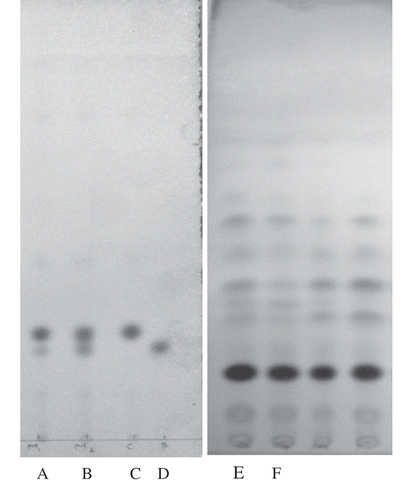
Figure 2 (a) RP-TLC of USM of ghee samples adulterated with adulternt oils: A: 1% groundnut oil adulterated cow ghee; B: 2% groundnut oil adulterated cow ghee; C: 5% groundnut oil adulterated cow ghee; D: 1% sunflower oil adulterated cow ghee; E: 2% sunflower oil adulterated cow ghee; F: 5% sunflower oil adulterated cow ghee; G: 2% soybean oil adulterated cow ghee; H: Pure cow ghee; I: mixture (cholesterol+ß- sitosterol); (b) RP-TLC of USM of ghee samples adulterated with specific adulterant oils: A: mixture (cholesterol+ß-sitosterol); B: Pure cow ghee; C: 1% designer oil adulterated cow ghee; D: 2% designer oil adulterated cow ghee; E: 5% designer oil adulterated cow ghee; F: 10% designer oil adulterated cow ghee; G: 1% designer oil adulterated buffalo ghee; H: 2% designer oil adulterated buffalo ghee; I: 5% designer oil adulterated buffalo ghee; J: 10% designer oil.

Reversed-Phase High Performance Liquid Chromatographic (RP-HPLC) Conditions for the Profiling of USM
RP-HPLC conditions for the separation of standard sterols as described by De[Citation7] were adopted and standardized for the profiling of sterols in USM of ghee, vegetable oils, specific adulterant oil, and adulterated samples. The retention time of individual standard sterols (cholesterol, stigmasterol, campasterol, and β-sitosterol) and their mixture as obtained was 17.7 ± 0.2, 19.7 ± 0.2, 20.2 ± 0.2, and 22.7 ± 0.2 min (n = 6; n = number of samples), respectively. The results indicated that the cholesterol and β-sitosterol resolved properly as evident from their Rt values. However, stigmasterol and campsterol also co-eluted but did not resolve properly under the standard HPLC conditions attempted (). Since cholesterol and β-sitosterol resolved properly using the standardized HPLC method and β-sitosterol and cholesterol served as markers for vegetable oils and animal fats, respectively. Therefore, this standardized method was selected to compare the results with that of the RP-TLC method.
Validation of Standardized RP-HPLC Method
To validate the RP-HPLC method and to rule out the false positive results expected due to variation in management of the animals under different conditions, ghee samples from cotton tract area as well as samples prepared from milk from local dairy farms were also used in the study. The USM from these samples were subjected to RP-HPLC analysis to obtain the profile of sterols which is depicted in . A small variation in the retention time of cholesterol was observed in the samples used for the validation and was found to be 17.7 ± 0.2 min (n = 10; n = number of sample). It is evident from the RP-HPLC chromatograms that none of the samples showed any peak corresponding to the peak of ß-sitosterol. It was amply clear that in genuine ghee samples no peak corresponding to the Rt of ß-sitosterol was observed, hence the standardized method was found to be very specific in detecting the added refined vegetable oils and specific adulterant oil in ghee, wherein major sterol, i.e., ß-sitosterol, was the selected tracer component
Lower Limit of Detection of Adulterant Oils in Ghee
Detection limit was also calculated for the standard β-sitosterol and different adulterant oils based on the signal to noise ratio of 3 and 10. The lower limit of detection for the standard β-sitosterol was calculated as 0.007 mg/mL or 7 ppm. It is evident from the limit of detection (LOD) value that presence of 7 ppm β-sitosterol was sufficient to detect the added vegetable oils/fats in ghee. RP-HPLC analysis of USM of adulterated ghee samples revealed that lower level of detection in case of coconut oil was to the tune of 5 g/100 g, designer vegetable oil 2 g/100 g, refined soybean oil 1 g/100 g, refined sunflower and groundnut oil 2 g/100 g (, , and –). The results clearly indicated that both the RP-TLC and RP-HPLC methods are equally efficient in detection of adulteration of clarified milk fat with vegetable oils.
Conclusion
In the present study it was found that the developed RP-HPLC method was rapid and could detect the addition of vegetable oils to the tune of 1–5% (5 g/100 g coconut oil, 2 g/100 g specific adulterant oil, 1 g/100 g refined soybean oil, 2 g/100 g refined sunflower, and groundnut oil in ghee). The developed method was comparable to the RP-TLC method and found to be more sensitive for coconut oil detection in ghee. Validation studies indicated that the chance of obtaining false positive results were almost negligible.
Acknowledgments
The authors are thankful to the Director, National Dairy Research Institute, Karnal for providing necessary facilities for carrying out the research.
Funding
Due acknowledgement is being paid to Indian Council for Agricultural Research, New Delhi for funding the research.
References
- Nurrulhidayah, A.F.; Che Man, Y.B.; Amin, I.; Arieff Salleh, R.; Farawahidah, M.Y.; Shuhaimi, M.; Khatib, A. FTIR-ATR Spectroscopy Based Metabolite Fingerprinting As a Direct Determination of Butter Adulterated with Lard. Indian Journal of Food Properties 2015, 18, 372–379.
- Arun, K.; Lal, D.; Seth, R.; Sharma, V. Detection of Groundnut Oil and Vanaspati in Ghee by Thin Layer Chromatography. Indian Journal of Dairy Science 2005, 58, 250–252.
- Patel, A.M.; Sharma, V.; Lal, D.; Arora, S. Validation of Crystallization Time Test, Apparent Solidification Time Test and Complete Liquification Time Test for Detection of Adulteration in Ghee. Indian Journal of Dairy Science 2011, 64, 298–304.
- Mathew, T.V.; Kamath, K.S. Detection of Vegetable Oils in Ghee and Vice-Versa by Reverse Phase Thin Layer Chromatography. Research and Industry 1978, 23, 168–169.
- Anupama, R. A Rapid Reversed-Phase Thin Layer Chromatographic Protocol for Detection of Adulteration in Ghee (Clarified Milk Fat) with Vegetable Oils. Journal of Food Science and Technology 2015, 52, 2434–2439.
- Oh, H.I.; Shin, T.S.; Chang, E.J. Determination of Cholesterol in Milk and Dairy Products by High-Performance Liquid Chromatography. Asian-Australian Journal Animal Sciences 2001, 14, 1465–1469.
- De, S. Outlines of Dairy Technology; Oxford University Press: New Delhi, India, 2011.

